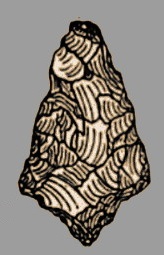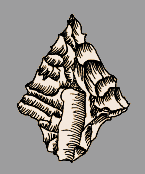Other Websites with Detailed Information:
Name Details:
Named By: William
Massey
Named For: La
Paz, Baja California, Mexico
Date Identified:
1961
Type Site:
La Paz
Cluster:
Commonly Utilized Material:
Date:
Cultural Period:
8,000 - 7,000 B.P.
Early Archaic
Middle Holocene
Glacial Period:
Culture:
Outline is Representative of Size and Shape:
Description of Physical Characteristics and Flaking Pattern:
This is a medium (2 to 3 inches) triangular contracting stem point with
an elliptical cross section. The blade ranges from straight to
slightly excurvate. The shoulder vary from slightly barbed to
horizontal. The stem contracts and ranges from ovoid to a sharp
point. This point commonly has a high quality of workmanship with
a random flaking pattern.
Size Measurements: Data
needed
Distribution:
Distribution Comments:
This point is primarily found in central to southern Baja California,
Mexico.

Similar Points:
Acatita, Amargosa, Ano Nuevo, Augustin, Channel Island Barbed, Gatecliff, Gypsum Cave, La Mina,, Loreto, Manuela, Point Sal Barbed, Vandenberg Contracting Stem Related / Associated Points:
Loreto Additional Comments:
Loyd Doty notes:
LA PAZ – is Spanish and short for Nuestra Señora de La Paz, and means our
lady of peace. This point type was named by archaeologist
William Massey for examples recovered from sites near the city of La Paz in
central and southern Baja California. He interpreted La Paz points as more finely flaked forms derived from
the Gypsum Cave type and as belonging to the Amargosa II complex. They are medium sized (2” to 3”) projectiles and knives with sharp
tips, strong, barbed shoulders and with tapered or ovate stems. Archaeologist Makoto Kowta believed the La Paz and Loreto Blades belong to
the Coxcatlan Complex of the Tehuacan Valley in the State of Puebla in
Mexico, which would place them firmly within the early Archaic period. Reference: Massey, William C.
1961, The Cultural Distinction of Aboriginal Baja
California. In: Homenaje a Pablo Martínez del Río
en el vigésimoquinto aniversario de la primera edición de “Los orígenes
americanos”, pp. 411-422. Instituto Nacional de Antropología e
Historia, Mexico City.
Pictures:


Other points in this Cluster:
Point Validity: Valid Type
Massey was a distinguished anthropologist who conductied extensive studies
into the archaeology of Baja California. This type was defined in a
professional publication and has many professional references. This is
considered a valid type.
.
Age Details:
Pictures Provided By:
A special thanks to Loyd Doty for providing additional information and
pictures.
As illustrated by Ritter and Burcell, 1998
References: (See Reference Page, Entry Number):
92, 186, 187
La Paz Projectile Point, La Paz Arrowhead


